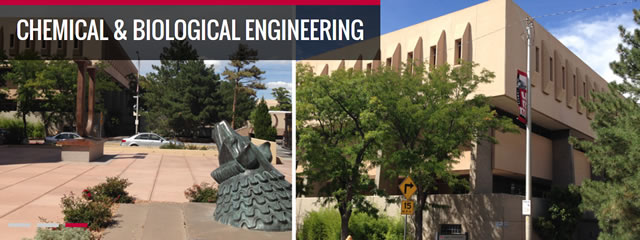
Chemical and Biological Engineering ETDs
Publication Date
6-24-2010
Abstract
This dissertation focuses on the characterization of two surfaces: mixed self-assembled monolayers (SAMs) of hexa(ethylene glycol) and alkyl thiolates (mixed SAM) and poly(N-isopropylacrylamide) (PNIPAAm). The synthesis of hexa(ethylene gylcol) alkyl thiol (C11EG6OH) is presented along with the mass spectrometry and nuclear magnetic resonance results. The mixed SAM surface was confirmed to be thermally responsive by contact angle goniometry, 35° at 28 °C and 55° at 40 °C. In addition, the mixed SAM surfaces were confirmed to be thermally responsive for various aqueous mediums by tensiometry. Factors such as oxygen, age, and surface mole fraction and how they affect the thermal response of the mixed SAM are discussed. Lastly, rat fibroblasts were grown on the mixed SAM and imaged by phase contrast microscopy to show inhibition of attachment at temperatures below the molecular transition. Qualitative and quantitative measurements of the fibroblast adhesion data are provided that support the hypothesis of the mixed SAM exhibiting a dominantly non-fouling molecular conformation at 25 °C whereas it exhibits a dominantly fouling molecular conformation at 40 °C. The adhesion of six model proteins: bovine serum albumin, collagen, pyruvate kinase, cholera toxin subunit B, ribonuclease, and lysozyme to the model thermally responsive mixed SAM were examined using AFM. All six proteins demonstrated adhesion to the pure component alkyl thiol, and in contrast demonstrated no adhesion to the pure component C11EG6OH SAM at both temperatures examined, 25 and 40 °C. The protein adhesion data to the mixed SAM also supports the hypothesis that the mixed SAM displays a non-fouling molecular conformation at 25 °C whereas it displays a dominantly fouling molecular conformation at 40 °C. PNIPAAm brushes grown on a silicon substrate by atom-transfer radical polymerization (ATRP) were imaged by AFM and characterized by XPS. The height of the resulting brushes could be controlled from 5 to 55 nm by reaction time. A thermal response was observed for polymer brushes with a length greater than 20 nm. For polymer brush lengths greater than 20 nm, the static contact angle at 22 °C was 35° and varied from 60 to 80° at 40 °C. The thermal response was also observed using the captive bubble method. Force-distance curves of the PNIPAAm brushes were taken with an unmodified silicon nitride AFM cantilever at incremental temperature steps. At room temperature the force-distance data was fit to the Alexander-de Gennes model resulting in a hydrated polymer length of 235 nm. The Youngs modulus was calculated using the Hertz model and changed from 80 MPa at 26 °C to 350 MPa at 40 °C. The solvent condition of the Alexander-de Gennes model was set to the case of good solvent and showed close match to the force-distance data at 26 °C. The match was not as close when the solvent condition was set to theta solvent condition and compared to the force-distance data at 40 °C.'
Keywords
Bioadhesion, Thermally Responsive Surfaces; Fouling, Adhesion, Monomolecular films--Thermal properties, Fibroblasts--Adhesion, Proteins--Surfaces, Ethylene glycol, Thiols, Alkylation, Acrylamide
Sponsors
National Science Foundation Office of Naval Research Defense Threat Reduction Agency German State of Baden-Wurttemberg
Document Type
Dissertation
Language
English
Degree Name
Chemical Engineering
Level of Degree
Doctoral
Department Name
Chemical and Biological Engineering
First Committee Member (Chair)
Whitten, David
Second Committee Member
Canavan, Heather
Third Committee Member
Dirk, Elizabeth
Fourth Committee Member
Keller, David
Recommended Citation
Andrzejewski, Brett. "Bioadhesion to model thermally responsive surfaces." (2010). https://digitalrepository.unm.edu/cbe_etds/32
